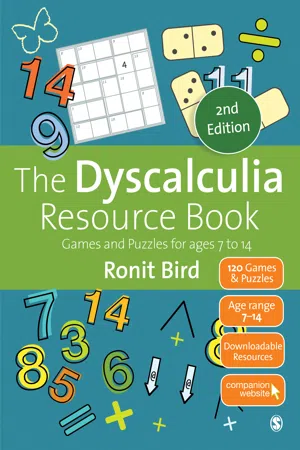
- 272 pages
- English
- ePUB (mobile friendly)
- Available on iOS & Android
eBook - ePub
About this book
Written by a teacher for teachers, the second edition of Ronit Bird's The Dyscalculia Resource Book now comes with 120 games and puzzles and a brand new section on 'mixed operations puzzles' which require learners to switch mentally between addition, subtraction, multiplication and division.
The new edition will also provide access to an accompanying website featuring demo videos of different games and puzzles and the option to easily download and print all the games and puzzles in the book!
Ideal for working with students 7 to 14 years old, this is the perfect companion to The Dyscalculia Toolkit, essential additions to every teachers' resource collection.
Frequently asked questions
Yes, you can cancel anytime from the Subscription tab in your account settings on the Perlego website. Your subscription will stay active until the end of your current billing period. Learn how to cancel your subscription.
No, books cannot be downloaded as external files, such as PDFs, for use outside of Perlego. However, you can download books within the Perlego app for offline reading on mobile or tablet. Learn more here.
Perlego offers two plans: Essential and Complete
- Essential is ideal for learners and professionals who enjoy exploring a wide range of subjects. Access the Essential Library with 800,000+ trusted titles and best-sellers across business, personal growth, and the humanities. Includes unlimited reading time and Standard Read Aloud voice.
- Complete: Perfect for advanced learners and researchers needing full, unrestricted access. Unlock 1.4M+ books across hundreds of subjects, including academic and specialized titles. The Complete Plan also includes advanced features like Premium Read Aloud and Research Assistant.
We are an online textbook subscription service, where you can get access to an entire online library for less than the price of a single book per month. With over 1 million books across 1000+ topics, we’ve got you covered! Learn more here.
Look out for the read-aloud symbol on your next book to see if you can listen to it. The read-aloud tool reads text aloud for you, highlighting the text as it is being read. You can pause it, speed it up and slow it down. Learn more here.
Yes! You can use the Perlego app on both iOS or Android devices to read anytime, anywhere — even offline. Perfect for commutes or when you’re on the go.
Please note we cannot support devices running on iOS 13 and Android 7 or earlier. Learn more about using the app.
Please note we cannot support devices running on iOS 13 and Android 7 or earlier. Learn more about using the app.
Yes, you can access The Dyscalculia Resource Book by Ronit Bird in PDF and/or ePUB format, as well as other popular books in Education & Inclusive Education. We have over one million books available in our catalogue for you to explore.
Information
Overview Tables
Part I Overview Table
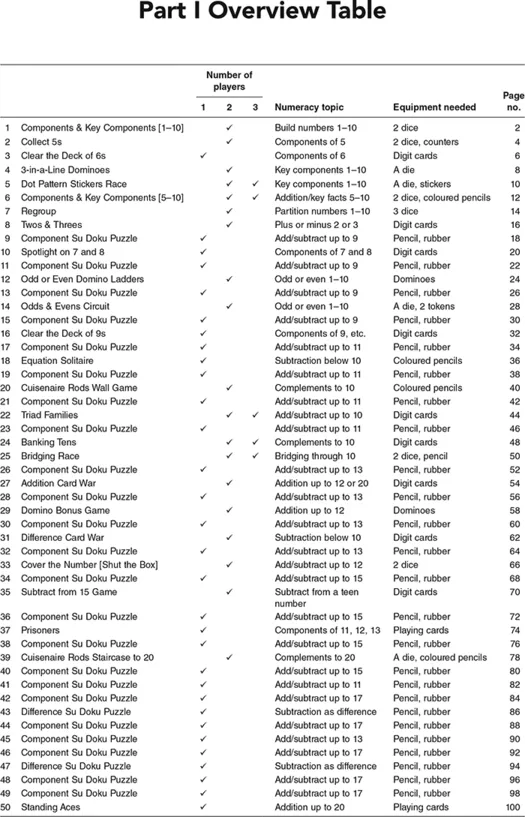
Part II Overview Table

Part III Overview Table
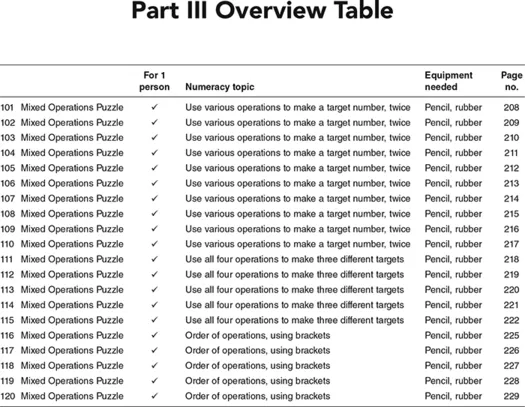
Part I Addition and Subtraction Games and Puzzles
1 Components & Key Components [1–10] – a game for 2 players
Teaching points
- The key components of all the numbers up to 10. The words ‘key components’ here refer to the doubles and near-doubles facts, e.g. 5 and 4 are the key components of 9.
- Practice in recognising the dice patterns.
- Only the numbers 1 to 5 (but not 6) are key components of the numbers up to 10.
- The same small number can be one of the key components of up to three larger numbers. For example, the number 4 is one of the key components of 7 and of 8 and of 9.
- Any number can be built by combining two smaller quantities (the basis of addition).
- Any number can be partitioned into two smaller components (the basis of subtraction).
Note to member of staff or parent
- Make sure the child is learning to recognise the dice patterns, not counting the dice spots.
- The child is not allowed to add by counting in ones, on fingers or otherwise. Anyone who is not yet at this stage should spend more time learning through concrete materials.
- Explain to the child that ‘key facts’ are so called because they are important facts that unlock a logical route to other, related facts. A focus on key facts, e.g. learning a single fact for each number up to 10, means minimising the number of facts that have to be committed to memory.
- Make sure the child understands what is meant by ‘key components’. For example, 5 and 4 are the key components of 9 because 5 + 4 is a near-doubles fact. Other components of 9 are 3 and 6, or 2 and 7, or 8 and 1, but these facts are not key facts.
- Point out to the child that the colouring task is a way of highlighting the most important combinations, i.e. the key component facts, not simply a way of scoring this game.
- Once both players have had nine turns each to throw the dice and draw the dominoes, it is the child who should undertake the scoring by finding, colouring and reading aloud the key facts on both players’ boards.
- The game should be played more than once and on more than one occasion.
Equipment needed
Two ordinary 6-sided spot dice. A second game board for an opponent. A pencil each and two coloured pencils in two different colours.
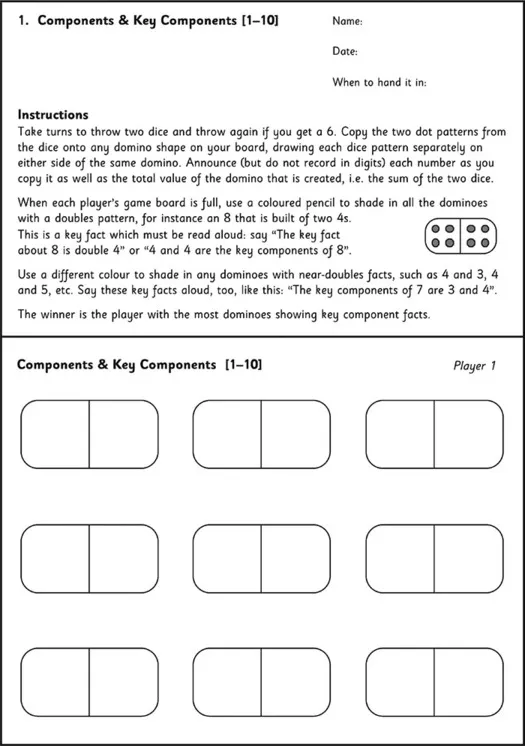
The Dyscalculia Resource Book © Ronit Bird, 2017 (SAGE)
2 Collect 5s – a game for 2 players
Teaching points
- There are only two ways of building the number 5 from two components.
- Inside the pattern of 5 one can see the pattern of 3 superimposed onto the pattern of 2.
- Inside the pattern of 5 one can see the pattern of 1 superimposed onto the pattern of 4.
- The commutativity of addition, i.e. 4 + 1 is the same as 1 + 4, and 2 + 3 = 3 + 2.
- Mental addition of two numbers below 5 to create a total of between 2 and 8.
- Moving away from using concrete materials in order to combine these small quantities and towards the stage of using visualisation techniques to find the answers mentally.
Note to member of staff or parent
- Make sure the child is recognising the dice patterns, not counting the dice spots.
- Make sure the child is not adding by counting in ones, on fingers or otherwise.
- Be sure to talk about what is going on at each step, especially when either player puts two components together to make 5.
- At first, prepare two game boards to suit the size of your counters.
- After playing a few times, preferably on different occasions, try the more abstract version of the game using the two boards on the next page.
Equipment needed
Two 6-sided spot dice, altered as follows: cover the patterns of 5 and 6 with a sticker and cover the stickers on one die with one pattern of 2 and one pattern of 3, and on the other die with one pattern of 4 and one pattern of 1. Counters in two colours (later, coloured pencils in two colours). Two paper game boards on which are drawn five patterns of 5, making sure the drawn circles roughly match the size of your counters.
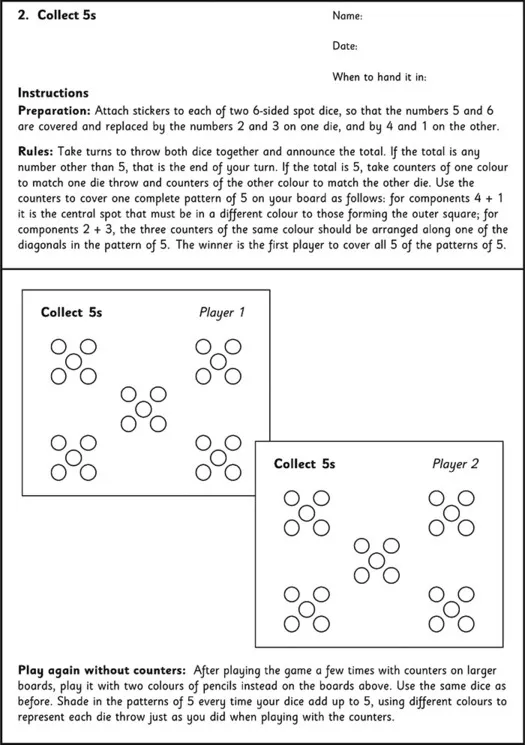
The Dyscalculia Resource Book © Ronit Bird, 2017 (SAGE)
3 Clear the Deck of 6s – a game for 1 player
Teaching points
- Components of 6. There are only three ways of building the number 6 from two components.
- The connection between addition, subtraction and missing addend problems.
- Mental addition of two numbers up to a total of 10.
Note to member of staff or parent
- Make sure the child knows that adding in ones, on fingers or otherwise, is not allowed.
- As the child picks up pairs of cards during play, both numbers should be spoken aloud.
- Make sure the target number is spelled out clearly. Although the layout of the cards makes no difference to the game, an arrangement of two rows of three may act as a reminder of this game’s target number, which is 6.
- The game should be played more than once and on more than one occasion. Encourage the child to keep playing until the components of 6 are easily recognised, rather than calculated.
Equipment needed
A pack of cards made up of four each of the numbers 1 to 5 inclusive. If you have no digit cards, remove the appropriate cards from a standard pack of playing cards and treat the Aces as 1s.

The Dyscalculia Resource Book © Ronit Bird, 2017 (SAGE)
4 3-in-a-Line Dominoes – a game for 2 players
Teaching points
- The ke...
Table of contents
- The Dyscalculia Resource Book
- The Dyscalculia Resource Book
- Contents
- About the Author
- About the Companion Website
- Accessing the Companion Website
- Introduction
- Overview Tables
- Part I Addition and Subtraction Games and Puzzles
- 1 Components & Key Components [1–10] – a game for 2 players
- 2 Collect 5s – a game for 2 players
- 3 Clear the Deck of 6s – a game for 1 player
- 4 3-in-a-Line Dominoes – a game for 2 players
- 5 Dot Pattern Stickers Race – a game for 2 or 3 players
- 6 Components & Key Components [5–10] – a game for 2 or 3 players
- 7 Regroup – a game for 2 players
- 8 Twos & Threes – a game for 2 players
- 9 Component Su Doku Puzzle
- 10 Spotlight on 7 and 8 – a game for 1 player
- 11 Component Su Doku Puzzle
- 12 Odd or Even Domino Ladders –a game for 2 players
- 13 Component Su Doku Puzzle
- 14 Odds & Evens Circuit – a game for 2 players
- 15 Component Su Doku Puzzle
- 16 Clear the Deck of 9s – a game for 1 player
- 17 Component Su Doku Puzzle
- 18 Equation Solitaire – a game for 1 player
- 19 Component Su Doku Puzzle
- 20 Cuisenaire Rods Wall Game – a game for 2 players
- 21 Component Su Doku Puzzle
- 22 Triad Families – a game for 2 or 3 players
- 23 Component Su Doku Puzzle
- 24 Banking Tens – a game for 2 or 3 players
- 25 Bridging Race – a game for 2 or 3 players
- 26 Component Su Doku Puzzle
- 27 Addition Card War – a game for 2 players
- 28 Component Su Doku Puzzle
- 29 Domino Bonus Game – a game for 2 players
- 30 Component Su Doku Puzzle
- 31 Difference Card War – a game for 2 players
- 32 Component Su Doku Puzzle
- 33 Cover the Number [Shut the Box] –a game for 2 players
- 34 Component Su Doku Puzzle
- 35 Subtract from 15 Game
- 36 Component Su Doku Puzzle
- 37 Prisoners – a game for 1 player
- 38 Component Su Doku Puzzle
- 39 Cuisenaire Rods Staircase to 20 –a game for 2 players
- 40 Component Su Doku Puzzle
- 41 Component Su Doku Puzzle
- 42 Component Su Doku Puzzle
- 43 Difference Su Doku Puzzle
- 44 Component Su Doku Puzzle
- 45 Component Su Doku Puzzle
- 46 Component Su Doku Puzzle
- 47 Difference Su Doku Puzzle
- 48 Component Su Doku Puzzle
- 49 Component Su Doku Puzzle
- 50 Standing Aces – a game for 1 player
- Part II Multiplication Tables and Division Games and Puzzles
- 51 Double & Half Dominoes – a game for 2 players
- 52 Cuisenaire Rods Pyramid – a game for 2 players
- 53 Butterfly Doubles [1–6] – a game for 2 players
- 54 Halving Odd Multiples of Ten –a game for 1 player
- 55 MAD [Multiplication and Division] Puzzles
- 56 The 2 & 4 Times Tables Race –a game for 2 players
- 57 Five is Half of Ten – a game for 2 players
- 58 The 3x Table Coin Solitaire –a game for 1 player
- 59 MAD [Multiplication and Division] Puzzles
- 60 Key Multiples Bingo – a game for 2 players
- 61 MAD Puzzle
- 62 Nines All-in-a-Row [9 is 1 less than 10] – a game for 2 players
- 63 MAD Puzzle
- 64 The 9x Table Coin Solitaire –a game for 1 player
- 65 MAD Puzzle
- 66 Don’t Walk if You Can Take the Bus! – games for 2 players
- 67 MAD Puzzle
- 68 The 6x Table Coin Solitaire –a game for 1 player
- 69 MAD Puzzle
- 70 The 3 & 6 Times Tables Race –a game for 2 players
- 71 MAD Puzzle
- 72 Butterfly Doubles [7–9] – a game for 2 players
- 73 MAD Puzzle
- 74 Tables on a Number Line –a game for 2 players
- 75 MAD Puzzle
- 76 The 7x Table Coin Solitaire –a game for 1 player
- 77 MAD Puzzle
- 78 Compete for the Harder Facts of the 7x Table – a game for 2 players
- 79 MAD Puzzle
- 80 Advanced Doubling & Halving Track Race – a game for 2 or 3 players
- 81 MAD Puzzle
- 82 The 8x Table Coin Solitaire –a game for 1 player
- 83 MAD Puzzle
- 84 Compete for the Harder Facts of the 8x Table – a game for 2 players
- 85 MAD Puzzle
- 86 The 4 & 8 Times Tables Race –a game for 2 players
- 87 MAD Puzzle
- 88 Top of the Tables Square – a game for 2 players
- 89 MAD Puzzle
- 90 Areas on a Grid – a game for 2 or 3 players
- 91 MAD Puzzle
- 92 MAD Puzzle
- 93 Factors Track Race – a game for 2 players
- 94 MAD Puzzle
- 95 MAD Puzzle
- 96 MAD Puzzle
- 97 MAD Puzzle
- 98 MAD Puzzle
- 99 MAD Puzzle
- 100 R for Remainder – a game for 2 or 3 players
- Part III Mixed Operations Puzzles
- 100 – 115 Mixed Operations Puzzles [These instructions and notes apply to the following 15 puzzles]
- 116 – 120 Mixed Operations Puzzles [These instructions and notes apply to the following 5 puzzles]
- Solutions to Su Doku Puzzles
- Solutions to MAD Puzzles
- Solutions to Mixed perations Puzzles
- Appendix
- Glossary